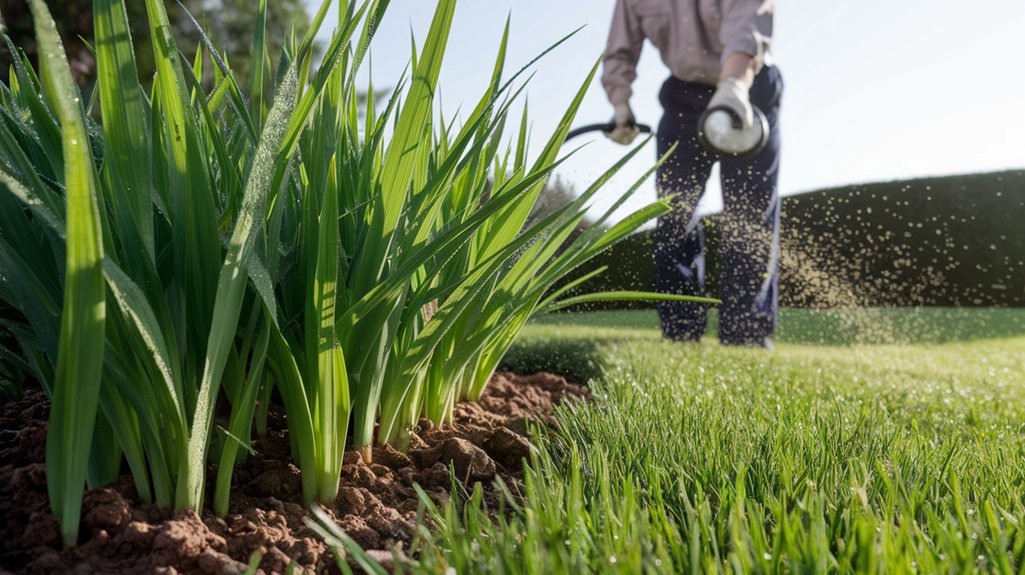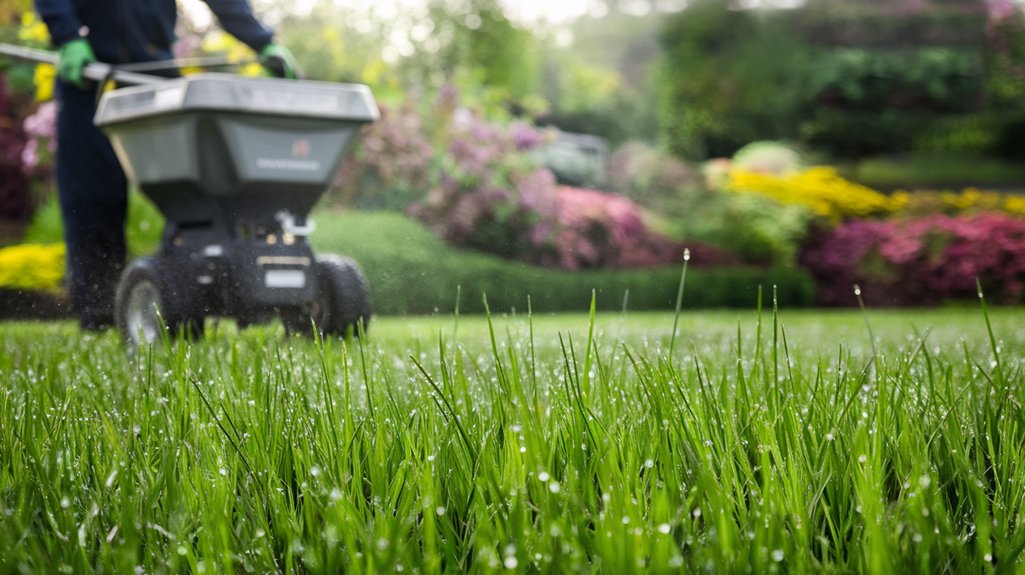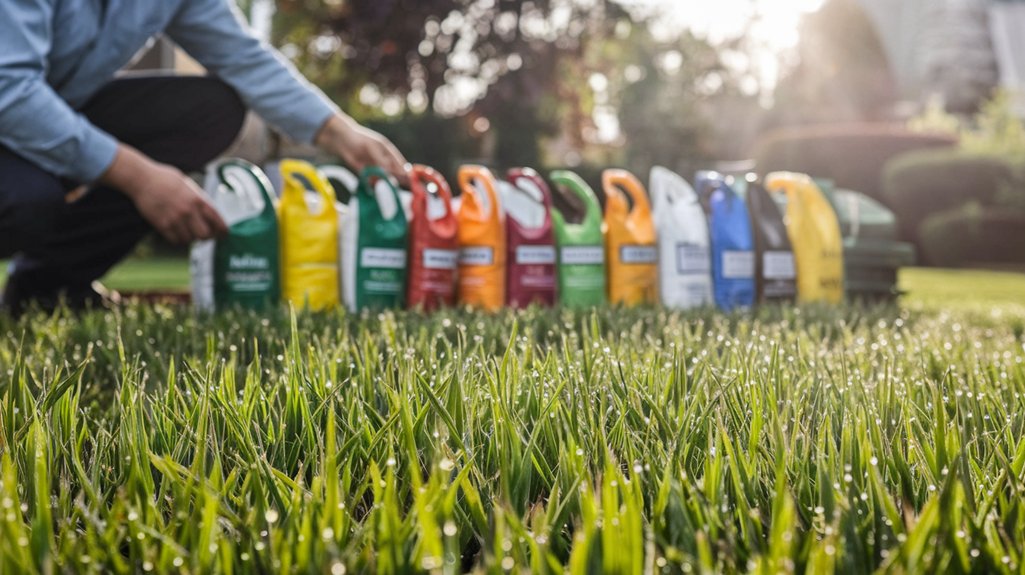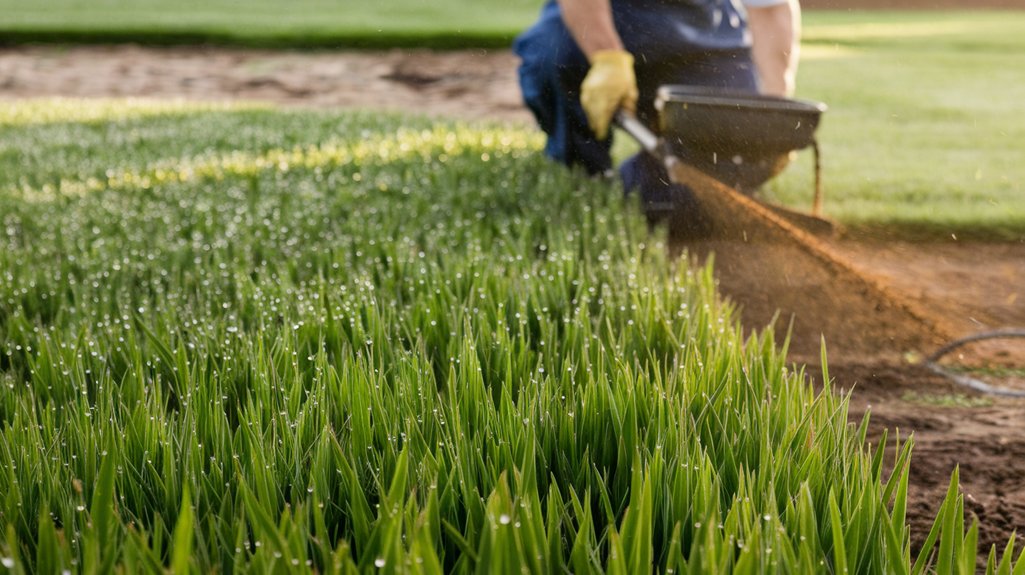When it comes to maintaining a lush, green lawn, you might underestimate the importance of professional fertilization. Many homeowners think they can handle it themselves, but there’s more to it than just spreading some fertilizer. Understanding your lawn’s unique needs can make all the difference in its health and appearance. Curious about how professionals achieve that vibrant look? Let’s explore the key factors that contribute to a thriving outdoor space.
Understanding the Importance of Lawn Fertilization

When you think about a lush, green lawn, it’s easy to overlook the vital role of fertilization. To maintain a thriving yard, you need to understand lawn nutrient balance. Each nutrient plays a specific role in your grass’s health, supporting everything from root development to disease resistance.
As the seasons change, your lawn goes through growth cycles that require different nutrients. For example, spring is a time for nitrogen to promote lush growth, while fall calls for potassium to prepare your lawn for winter.
Lawn Fertilization Secrets ensure thriving yards. Learn lawn care from Colorado State University Extension.
The Benefits of Professional Expertise

Understanding the importance of proper lawn fertilization sets the stage for why professional expertise can make a significant difference.
When you hire a lawn care professional, you gain access to expert advice that’s tailored to your specific needs. They assess your lawn’s unique conditions, from soil type to local climate, ensuring you receive customized solutions that promote healthy growth.
Professionals have the knowledge to identify nutrient deficiencies and the right products to address them. This means you won’t waste time or money on ineffective treatments.
Plus, their experience allows them to implement the best fertilization practices, which can enhance the overall health and appearance of your lawn.
Trusting experts ultimately leads to a thriving, vibrant outdoor space you can enjoy all year round.
Tailored Fertilization Plans for Your Lawn

To ensure your lawn thrives, a tailored fertilization plan is essential. This isn’t a one-size-fits-all approach; your lawn has unique needs that require customized nutrient plans.
By working with professionals, you can benefit from:
- Precision application: Target the specific nutrients your lawn needs.
- Seasonal adjustment strategies: Adapt your fertilization routine as the seasons change to maximize growth.
- Long-term health: Build a resilient lawn that can withstand pests and weather fluctuations.
With these strategies, you’ll see a noticeable difference in your lawn’s health and appearance.
Investing in a tailored fertilization plan not only helps you achieve that lush, green look but also supports the overall ecosystem of your yard. It’s a smart move for any homeowner who cares about their outdoor space.
The Role of Soil Testing in Fertilization
Soil testing is a crucial step in developing an effective fertilization strategy for your lawn. By analyzing your soil composition, you can identify specific nutrient deficiencies that could hinder your lawn’s growth. This targeted approach ensures that you’re not just throwing fertilizer at your lawn without understanding its needs.
| Soil Component | Recommended Level | Action Needed |
|---|---|---|
| Nitrogen | 10-20 ppm | Add nitrogen-rich fertilizer |
| Phosphorus | 15-30 ppm | Amend with phosphate |
| Potassium | 100-150 ppm | Apply potassium supplements |
With the results from soil testing, you’ll know exactly what your lawn needs to thrive, allowing you to make informed decisions for a lush, green yard.
Choosing the Right Fertilizer for Your Grass Type
Choosing the right fertilizer for your grass type can make a significant difference in your lawn’s health and appearance.
Different grass types require specific fertilizer compositions to thrive. Here’s what to consider when selecting the right one:
- Nitrogen (N): Essential for lush, green growth; look for fertilizers high in nitrogen for cool-season grasses.
- Phosphorus (P): Promotes root development; opt for a balanced fertilizer if you’re growing warm-season grasses.
- Potassium (K): Increases drought resistance and overall health; ensure your fertilizer contains adequate potassium.
Timing and Frequency of Fertilization
Timing and frequency of fertilization play a crucial role in maintaining a healthy lawn, as applying fertilizer at the right moments ensures your grass receives the nutrients it needs when it can utilize them most effectively.
For optimal results, you should focus on two key periods: spring and fall fertilization. In spring, as your grass begins to wake up, applying fertilizer helps promote vigorous growth and color. Aim for late April to early May for the best results.
In the fall, fertilizing between September and October prepares your lawn for the winter months, enhancing root development and resilience.
The Impact of Fertilization on Lawn Health
While many factors contribute to a healthy lawn, the impact of fertilization stands out as one of the most significant.
When you fertilize your lawn, you’re not just feeding the grass; you’re enhancing its overall health and vigor. Proper fertilization promotes lush lawn growth and helps maintain a nutrient balance that prevents deficiencies.
Consider these benefits of professional fertilization:
- Improved Color: A well-fertilized lawn boasts a vibrant green hue.
- Enhanced Root Development: Strong roots lead to better drought and disease resistance.
- Boosted Growth Rate: Regular feeding accelerates growth, filling in bare patches quickly.
How Professional Care Enhances Resilience Against Pests
When you invest in professional lawn care, you’re not only nurturing your grass but also fortifying it against pests.
A well-fertilized lawn boosts its vitality, making it more resilient to harmful insects and diseases. Professionals use targeted treatments that enhance pest resistance, ensuring your lawn can withstand invasions that could otherwise compromise its health.
By focusing on the right nutrients and soil conditions, they create an environment where grass thrives and pests struggle to survive. This proactive approach means fewer infestations and less need for chemical treatments, allowing you to enjoy a lush, vibrant lawn with minimal worry.
Embracing professional care is an essential step in safeguarding your outdoor space while promoting long-lasting beauty.
Long-Term Cost Savings of Professional Lawn Fertilization
Investing in professional lawn fertilization not only enhances your lawn’s health but also leads to significant long-term cost savings.
By treating your lawn right from the start, you’ll avoid expenses related to unhealthy grass and invasive pests. Proper care is a smart choice for budget planning and proves to be a long-term investment.
Consider these benefits:
- Reduced need for repairs: A healthy lawn minimizes the risk of damage, saving you on costly replacements.
- Lower water bills: Well-fertilized lawns retain moisture better, cutting your watering costs.
- Fewer pest management expenses: A robust lawn naturally resists pests, reducing the need for chemical treatments.
With professional fertilization, you’re not just spending; you’re investing in future savings!
Frequently Asked Questions
How Do Weather Conditions Affect Lawn Fertilization Schedules?
Weather conditions significantly impact your lawn fertilization schedule. You’ll need to make seasonal adjustments based on temperature effects. Warmer temperatures may accelerate growth, while cooler weather can slow nutrient absorption, requiring timely applications for optimal results.
Can I Fertilize My Lawn Myself and Still Achieve Professional Results?
Yes, you can fertilize your lawn yourself and achieve great results. By using DIY fertilization techniques and exploring cost-effective options, you’ll save money while still promoting a lush, healthy lawn. Just follow best practices!
What Are the Signs My Lawn Needs Fertilization?
You’ll notice signs your lawn needs fertilization when you see yellowing grass and patchy growth. These indicators suggest nutrient deficiencies, so addressing them promptly can help restore your lawn’s health and vibrancy.
Is There a Best Time of Year for Lawn Fertilization?
The best times for lawn fertilization are spring and fall. Spring fertilization helps promote growth, while fall fertilization strengthens roots before winter. Timing your fertilization right ensures a healthy, thriving lawn year-round.
How Does Over-Fertilization Impact My Lawn’s Health?
Over-fertilization can lead to a nutrient imbalance in your lawn, causing stress and damage. You might notice lawn burn, where grass turns brown and dies, ultimately harming the overall health and appearance of your yard.
In conclusion, investing in professional lawn fertilization is key to achieving that lush, green lawn you desire. With tailored plans, expert knowledge, and thorough soil testing, you’ll ensure your grass gets the right nutrients at the right time. This not only boosts your lawn’s health but also strengthens its resilience against pests. Plus, the long-term cost savings make it a smart choice. So, let the professionals help you create an outdoor space you can truly enjoy year-round!
Contact Us
Lawn Fertilization Secrets with Above & Beyond Services create vibrant Denver lawns. Call (720) 806-6378 or visit Above & Beyond Services for free quotes on lawn care, pest control, and more.
Key Takeaways
- Professional expertise ensures tailored fertilization plans that address specific lawn conditions and nutrient needs.
- Soil testing identifies deficiencies, guiding targeted strategies for optimal lawn health.
- Timely fertilization in spring and fall maximizes nutrient absorption and promotes vigorous growth.
- Customized nutrient applications build long-term resilience against pests and environmental stressors.
- Expert advice and implementation lead to a lush, vibrant lawn year-round, enhancing outdoor spaces.




